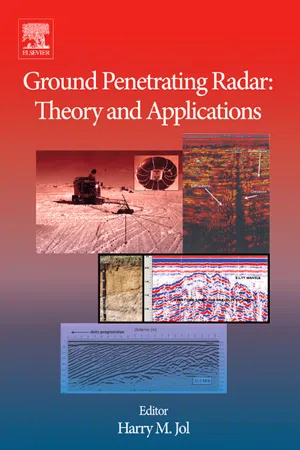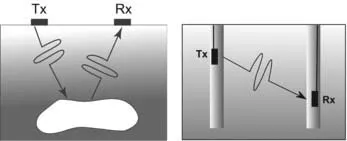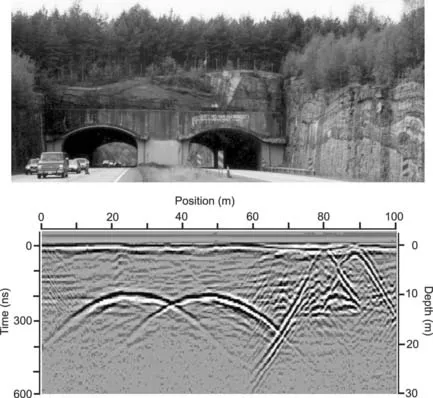Contents
1.1. Introduction
1.2. Ground penetrating Radar Basic Principles
1.2.1. Overview
1.2.2. Maxwell’s equations
1.2.3. Constitutive equations
1.2.4. Material properties
1.3. Wave Nature of Electromagnetic Fields
1.3.1. Wave properties
1.3.2. Ground penetrating radar source near an interface
1.3.3. Reflection, refraction, and transmission at interfaces
1.3.4. Resolution and zone of influence
1.3.5. Scattering attenuation
1.4. Signal Measurement
1.4.1. Time ranges and bandwidth
1.4.2. Center frequency
1.4.3. Ground penetrating radar signal acquisition
1.4.4. Characterizing system response
1.4.5. Recording dynamic range
1.4.6. Antennas
1.4.7. Antenna directivity
1.4.8. Antenna shielding
1.5. Survey Methodology
1.5.1.Sampling criteria
1.5.2. Ground penetrating radar surveys
1.5.3. Common-offset reflection survey
1.5.4. Multioffset common midpoint/wide-angle reflection and refraction velocity sounding design
1.5.5. Transillumination surveys
1.6. Data Analysis and Interpretation
1.6.1. Dewow
1.6.2. Time gain
1.6.3. Deconvolution
1.6.4. Migration
1.6.5. Topographic correction
1.6.6. Two-dimensional and three-dimensional data visualization
1.7. Summary
References
1.1 Introduction
Ground penetrating radar (GPR) is now a well-accepted geophysical technique. The method uses radio waves to probe “the ground” which means any low loss dielectric material. In its earliest inception, GPR was primarily applied to natural geologic materials. Now GPR is equally well applied to a host of other media such as wood, concrete, and asphalt.
The existence of numerous lossy dielectric material environments combined with the broad radio frequency spectrum leads to a wide range of GPR applications. The same methodology can be applied to glaciology and to nondestructive testing of concrete structures; the spatial scale of applications varies from kilometers to centimeters.
The most common form of GPR measurements deploys a transmitter and a receiver in a fixed geometry, which are moved over the surface to detect reflections from subsurface features. In some applications, transillumination of the volume under investigation is more useful. Both concepts are depicted in Figure 1.1. An example of GPR response is shown in Figure 1.2.
Use of radio waves to sound the earth was contemplated for decades before results were obtained in the 1950s (El Said, 1956; Waite and Schmidt, 1961). Waite’s demonstration of ice sheet sounding with aircraft radar altimeters leads to radio echo sounding in many locations around the world. From this start, there was a gradual transition of the concepts to sounding soils and rocks, which began in the 1960s, and has continued ever since.
From the early days, applications have mushroomed, our knowledge of the basic physics has grown in leaps and bounds, and the nature of material understanding has blossomed (Davis and Annan, 1989). A succinct historical summary is given by Annan (2002). Excellent discussions of the use of GPR for geologic stratigraphy can be found in Bristow and Jol (2003) and for hydrogeology in Rubin and Hubbard (2005).
Ground penetrating radar has evolved its own natural set of terminology, common understandings, and practical application procedures. The objective of this chapter is to provide a succinct overview of the key concepts, physical issues, and practical experiences that underpin the language, practice, and interpretation of GPR today.
1.2 Ground penetrating Radar Basic Principles
1.2.1 Overview
The foundations of GPR lie in electromagnetic (EM) theory. The history of this field spans more than two centuries and is the subject of numerous texts such as Jackson (1962) and Smythe (1989). This overview outlines the basic building blocks needed to work quantitatively with GPR.
Maxwell’s equations mathematically describe the physics of EM fields, while constitutive relationships quantify material properties. Combining the two provides the foundations for quantitatively describing GPR signals.
1.2.2 Maxwell’s equations
In mathematical terms, EM fields and relationships are expressed as follows:
where
is the electric field strength vector (V/m);
q is the electric charge density (C/m
3);
is the magnetic flux density vector (T);
is the electric current density vector (A/m
2);
is the electric displacement vector (C/m
2);
t is time (s); and
is the magnetic field intensity (A/m).
Maxwell succinctly summarized the work of numerous researchers in this compact form. From these relationships, all classic EMs (induction, radio waves, resistivity, circuit theory, etc.) can be derived when combined with formalism to characterize material electrical properties.
1.2.3 Constitutive equations
Constitutive relationships are the means of describing a material’s response to EM fields. For GPR, the electrical and magnetic properties are of importance. Constitutive equations (Equations (0070), (1.6) and (1.7)) provide a macroscopic (or average behavior) description of how electrons, atoms, and molecules respond en masse to the application of an EM field.
Electrical conductivity
characterizes free charge movement (creating electric current) when an electric field is present. Resistance to charge flow leads to energy dissipation. Dielectric permittivity
characterizes displa...
















